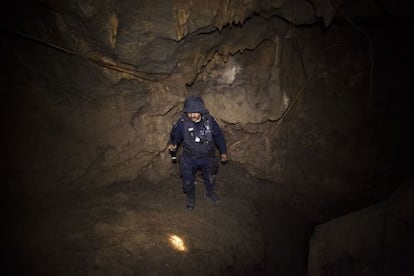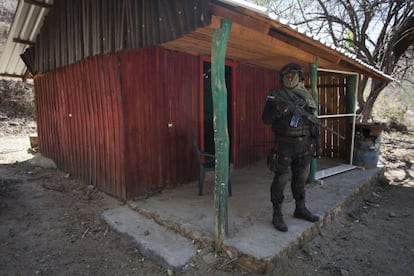A Mexican drug lord’s last steps
The head of the Knights Templar cartel spent the days before his arrest hiding in a cave


Some of Mexico’s most notorious drug traffickers come from the dry land where marijuana grows best.
Joaquín El Chapo Guzmán Loera is from the Badiraguato mountain range, while Servando Gómez, the recently captured leader of the Knights Templar, is a product of Michoacán’s Tierra Caliente region.
Authorities had been closing in on Gómez, or La Tuta, since January 2014. The former teacher became the chief of the cartel following the killing by Mexican troops of Nazario Moreno, known as El Chayo or El Más Loco.
After the ambush by Mexican marines, La Tuta became one of the most feared men in Tierra Caliente.
In Mexico, official stories are often filled with apocryphal anecdotes. They say that La Tuta helped the authorities track down El Chayo because he had become too crazy. It is also said the latter gave pieces of his victims’ hearts to his hit men to eat.
After the marines killed El Chayo, La Tuta became one of the most feared men in Tierra Caliente
But as the pressure began building, Gómez went into hiding last June, fleeing to the Cucha Ranch in the Michoacán mountains where he lived in a hut that had a caged parrot at its entrance. “It was there when we got here,” says one of the police officers guiding round a group of journalists from Mexico City.
El Chayo’s own ranch is located around five kilometers from here. “The parties went on from Friday to Monday, with music and cockfights,” says one officer, who describes it as luxurious.
On the other hand, the hut was nothing special in any way. It was simple, with some pigs and sheep grazing nearby. The only modern structure was a satellite TV antenna and the 40 kilometers of cable that the traffickers brought to connect it to the closest city, Apatzingán.
Even though La Tuta’s hideout was not luxurious, police said it was surrounded by six rings of protection, including bodyguards armed with Kalashnikov automatic weapons.
If Sinaloa cartel head Guzmán was the king of the cocaine, La Tuta was the king of methamphetamine, the dangerous, highly addicted stimulant that has become something of a cult narcotic after featuring at the center of hit TV series Breaking Bad. In fact, a few episodes feature a pair of vicious hit men twins from Michoacán.
Police believe that Gómez fled the ranch in September in order to look for another hideout. He began searching in the mountain region between Tumbiscatío and Arteaga, where he was born.
Desperate, Gómez hid for several weeks in a cave that the Templars had used to torture their victims.
Police Chief Enrique Galindo is keen to point out to journalists that the life of a trafficker is not what it usually seems: one can end up living on the run like La Tuta. “It is a miserable life,” he says.

Gómez eventually abandoned his cave, deciding that the best place to hide was where there were most people: the city. He chose Morelia, the capital of Michoacán.
He moved from one safe house to the next with the help of a small group of messengers. La Tuta never used a cellphone or any other electronic device to avoid any monitoring of his movements.
But the police were able to track him down after spotting one of his girlfriends enter a building with a cake on February 6 – his birthday.
The operation was set. At 3.30am on February 26, La Tuta left one of his safe houses for another while eight of his men waited to escort him.
Police moved in and arrested all of them without firing a single shot. “We didn’t even disturb the neighbors,” says Galindo.
The federal police had a score to settle. In 2009, La Tuta had captured 12 undercover officers who were searching for him and left their dismembered bodies on a highway.
“I am a trafficker but a good trafficker,” he reportedly told his captors.
One officer looked at him and responded: “Here, the good ones are the authorities.”
Tu suscripción se está usando en otro dispositivo
¿Quieres añadir otro usuario a tu suscripción?
Si continúas leyendo en este dispositivo, no se podrá leer en el otro.
FlechaTu suscripción se está usando en otro dispositivo y solo puedes acceder a EL PAÍS desde un dispositivo a la vez.
Si quieres compartir tu cuenta, cambia tu suscripción a la modalidad Premium, así podrás añadir otro usuario. Cada uno accederá con su propia cuenta de email, lo que os permitirá personalizar vuestra experiencia en EL PAÍS.
En el caso de no saber quién está usando tu cuenta, te recomendamos cambiar tu contraseña aquí.
Si decides continuar compartiendo tu cuenta, este mensaje se mostrará en tu dispositivo y en el de la otra persona que está usando tu cuenta de forma indefinida, afectando a tu experiencia de lectura. Puedes consultar aquí los términos y condiciones de la suscripción digital.








































